Exploring a Personal Model of Leadership: Servant Leadership
VerifiedAdded on 2023/06/03
|14
|3376
|439
Report
AI Summary
This report provides an overview of servant leadership as a personal leadership model, analyzing experiences as a leader in XYZ Pvt. Ltd. and the benefits compared to path-goal leadership. It reflects on core values, advantages, and disadvantages, emphasizing the importance of prioritizing employees to achieve organizational objectives. The report discusses vision, motivation, and relationships within servant leadership, highlighting traits of effective leaders and assumptions about employees. It contrasts the current path-goal leadership model with the servant leadership model, advocating for the latter's application to enhance employee participation, motivation, and overall organizational success. Recommendations for implementing and improving the servant leadership approach are also provided.
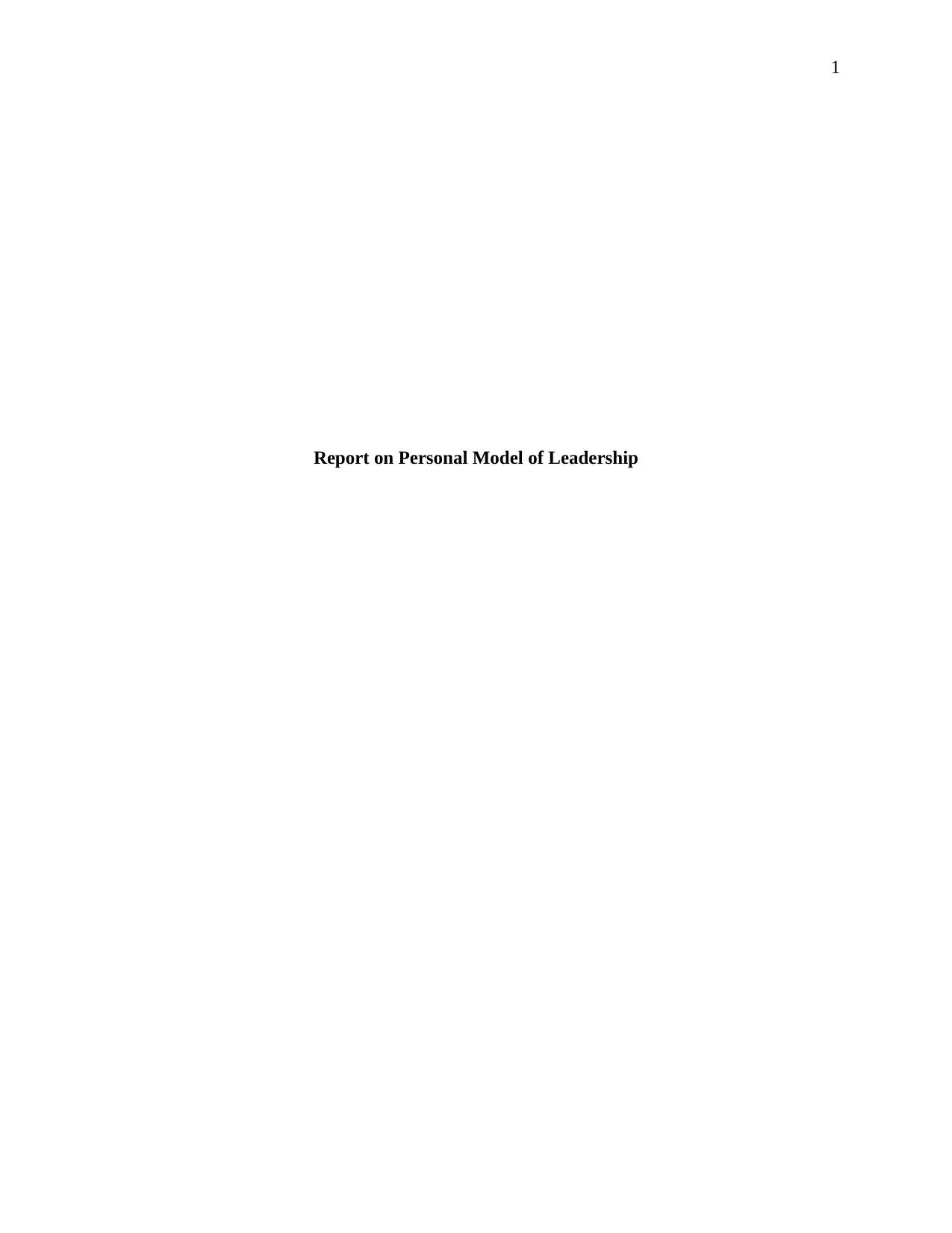
1
Report on Personal Model of Leadership
Report on Personal Model of Leadership
Paraphrase This Document
Need a fresh take? Get an instant paraphrase of this document with our AI Paraphraser
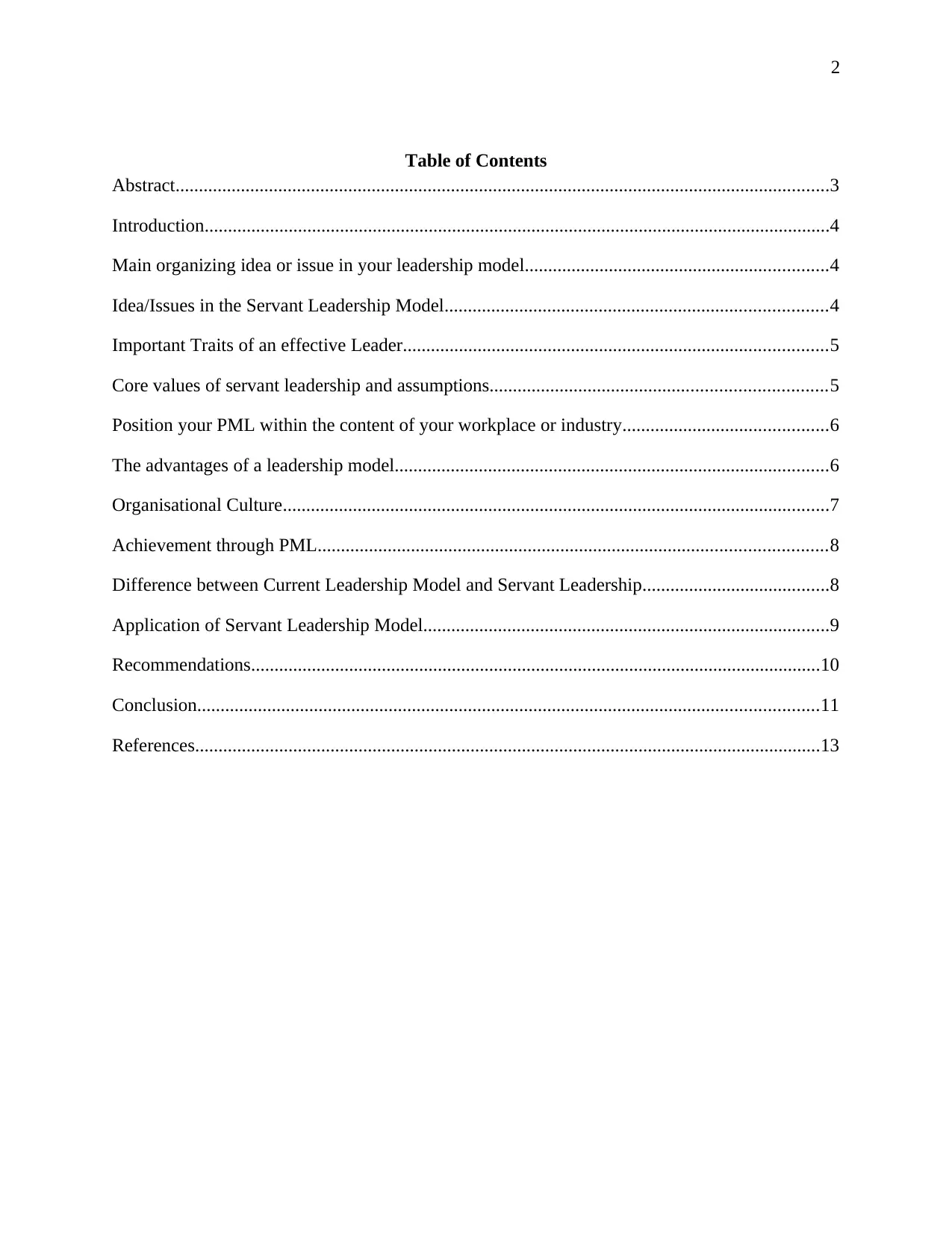
2
Table of Contents
Abstract............................................................................................................................................3
Introduction......................................................................................................................................4
Main organizing idea or issue in your leadership model.................................................................4
Idea/Issues in the Servant Leadership Model..................................................................................4
Important Traits of an effective Leader...........................................................................................5
Core values of servant leadership and assumptions........................................................................5
Position your PML within the content of your workplace or industry............................................6
The advantages of a leadership model.............................................................................................6
Organisational Culture.....................................................................................................................7
Achievement through PML.............................................................................................................8
Difference between Current Leadership Model and Servant Leadership........................................8
Application of Servant Leadership Model.......................................................................................9
Recommendations..........................................................................................................................10
Conclusion.....................................................................................................................................11
References......................................................................................................................................13
Table of Contents
Abstract............................................................................................................................................3
Introduction......................................................................................................................................4
Main organizing idea or issue in your leadership model.................................................................4
Idea/Issues in the Servant Leadership Model..................................................................................4
Important Traits of an effective Leader...........................................................................................5
Core values of servant leadership and assumptions........................................................................5
Position your PML within the content of your workplace or industry............................................6
The advantages of a leadership model.............................................................................................6
Organisational Culture.....................................................................................................................7
Achievement through PML.............................................................................................................8
Difference between Current Leadership Model and Servant Leadership........................................8
Application of Servant Leadership Model.......................................................................................9
Recommendations..........................................................................................................................10
Conclusion.....................................................................................................................................11
References......................................................................................................................................13
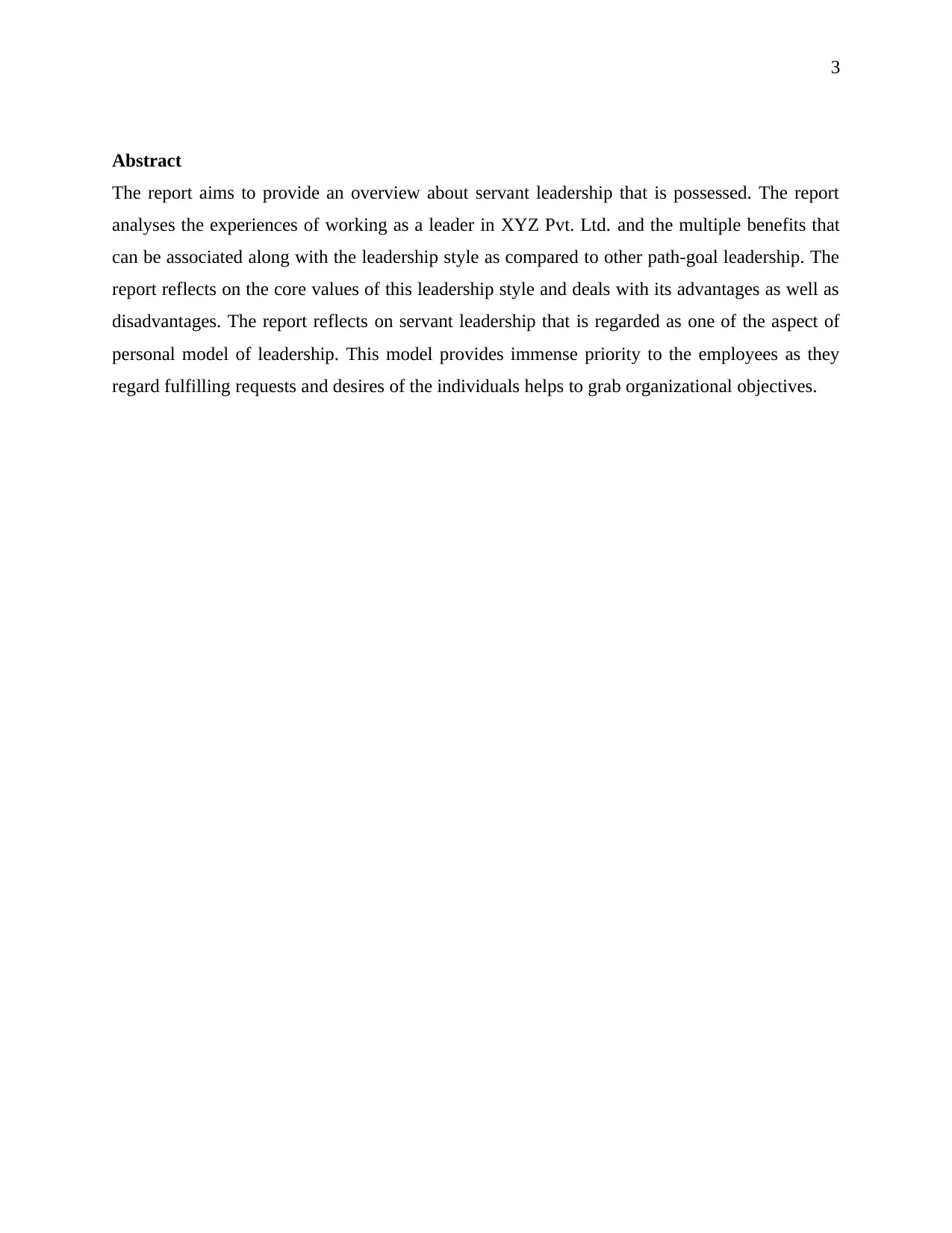
3
Abstract
The report aims to provide an overview about servant leadership that is possessed. The report
analyses the experiences of working as a leader in XYZ Pvt. Ltd. and the multiple benefits that
can be associated along with the leadership style as compared to other path-goal leadership. The
report reflects on the core values of this leadership style and deals with its advantages as well as
disadvantages. The report reflects on servant leadership that is regarded as one of the aspect of
personal model of leadership. This model provides immense priority to the employees as they
regard fulfilling requests and desires of the individuals helps to grab organizational objectives.
Abstract
The report aims to provide an overview about servant leadership that is possessed. The report
analyses the experiences of working as a leader in XYZ Pvt. Ltd. and the multiple benefits that
can be associated along with the leadership style as compared to other path-goal leadership. The
report reflects on the core values of this leadership style and deals with its advantages as well as
disadvantages. The report reflects on servant leadership that is regarded as one of the aspect of
personal model of leadership. This model provides immense priority to the employees as they
regard fulfilling requests and desires of the individuals helps to grab organizational objectives.
⊘ This is a preview!⊘
Do you want full access?
Subscribe today to unlock all pages.

Trusted by 1+ million students worldwide
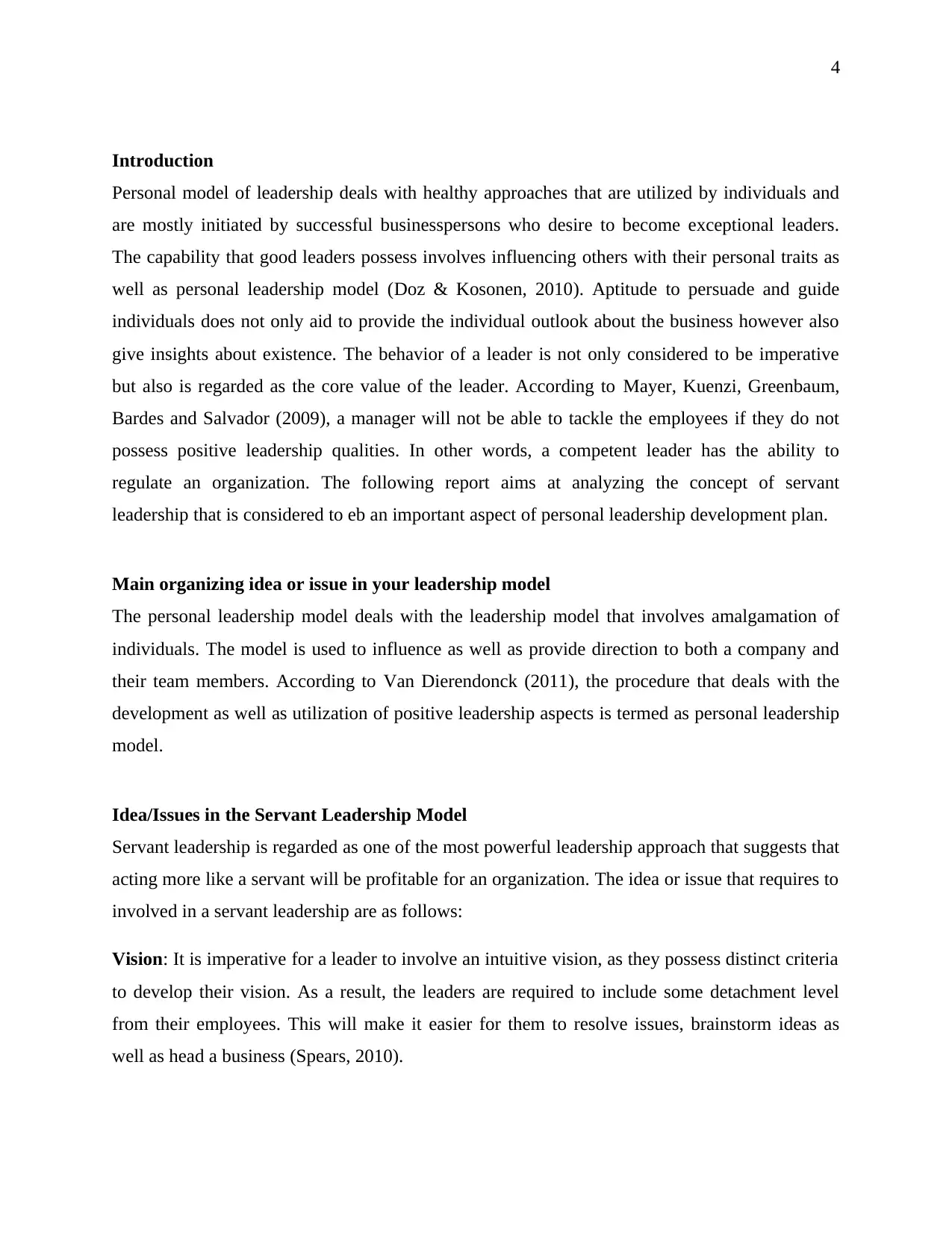
4
Introduction
Personal model of leadership deals with healthy approaches that are utilized by individuals and
are mostly initiated by successful businesspersons who desire to become exceptional leaders.
The capability that good leaders possess involves influencing others with their personal traits as
well as personal leadership model (Doz & Kosonen, 2010). Aptitude to persuade and guide
individuals does not only aid to provide the individual outlook about the business however also
give insights about existence. The behavior of a leader is not only considered to be imperative
but also is regarded as the core value of the leader. According to Mayer, Kuenzi, Greenbaum,
Bardes and Salvador (2009), a manager will not be able to tackle the employees if they do not
possess positive leadership qualities. In other words, a competent leader has the ability to
regulate an organization. The following report aims at analyzing the concept of servant
leadership that is considered to eb an important aspect of personal leadership development plan.
Main organizing idea or issue in your leadership model
The personal leadership model deals with the leadership model that involves amalgamation of
individuals. The model is used to influence as well as provide direction to both a company and
their team members. According to Van Dierendonck (2011), the procedure that deals with the
development as well as utilization of positive leadership aspects is termed as personal leadership
model.
Idea/Issues in the Servant Leadership Model
Servant leadership is regarded as one of the most powerful leadership approach that suggests that
acting more like a servant will be profitable for an organization. The idea or issue that requires to
involved in a servant leadership are as follows:
Vision: It is imperative for a leader to involve an intuitive vision, as they possess distinct criteria
to develop their vision. As a result, the leaders are required to include some detachment level
from their employees. This will make it easier for them to resolve issues, brainstorm ideas as
well as head a business (Spears, 2010).
Introduction
Personal model of leadership deals with healthy approaches that are utilized by individuals and
are mostly initiated by successful businesspersons who desire to become exceptional leaders.
The capability that good leaders possess involves influencing others with their personal traits as
well as personal leadership model (Doz & Kosonen, 2010). Aptitude to persuade and guide
individuals does not only aid to provide the individual outlook about the business however also
give insights about existence. The behavior of a leader is not only considered to be imperative
but also is regarded as the core value of the leader. According to Mayer, Kuenzi, Greenbaum,
Bardes and Salvador (2009), a manager will not be able to tackle the employees if they do not
possess positive leadership qualities. In other words, a competent leader has the ability to
regulate an organization. The following report aims at analyzing the concept of servant
leadership that is considered to eb an important aspect of personal leadership development plan.
Main organizing idea or issue in your leadership model
The personal leadership model deals with the leadership model that involves amalgamation of
individuals. The model is used to influence as well as provide direction to both a company and
their team members. According to Van Dierendonck (2011), the procedure that deals with the
development as well as utilization of positive leadership aspects is termed as personal leadership
model.
Idea/Issues in the Servant Leadership Model
Servant leadership is regarded as one of the most powerful leadership approach that suggests that
acting more like a servant will be profitable for an organization. The idea or issue that requires to
involved in a servant leadership are as follows:
Vision: It is imperative for a leader to involve an intuitive vision, as they possess distinct criteria
to develop their vision. As a result, the leaders are required to include some detachment level
from their employees. This will make it easier for them to resolve issues, brainstorm ideas as
well as head a business (Spears, 2010).
Paraphrase This Document
Need a fresh take? Get an instant paraphrase of this document with our AI Paraphraser
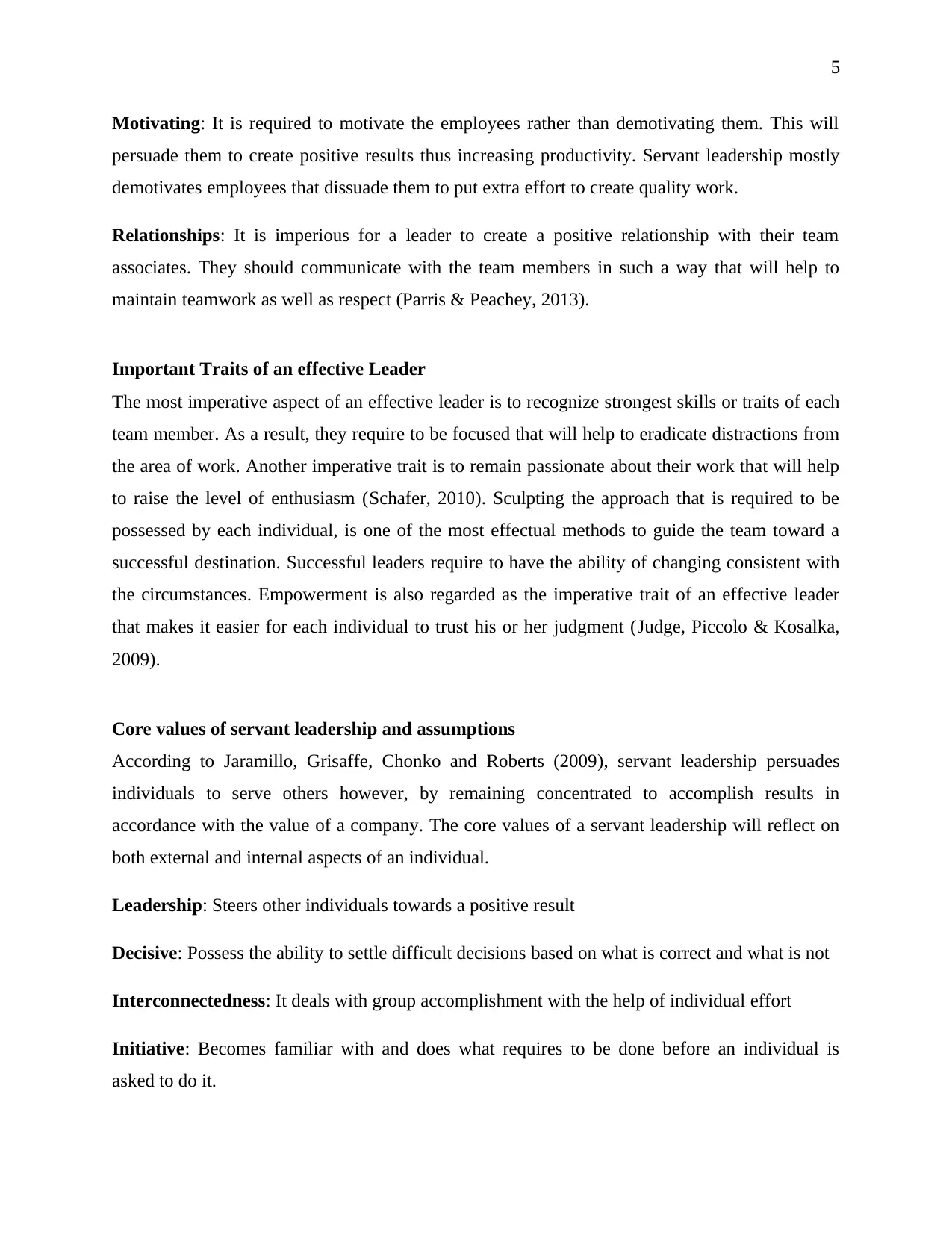
5
Motivating: It is required to motivate the employees rather than demotivating them. This will
persuade them to create positive results thus increasing productivity. Servant leadership mostly
demotivates employees that dissuade them to put extra effort to create quality work.
Relationships: It is imperious for a leader to create a positive relationship with their team
associates. They should communicate with the team members in such a way that will help to
maintain teamwork as well as respect (Parris & Peachey, 2013).
Important Traits of an effective Leader
The most imperative aspect of an effective leader is to recognize strongest skills or traits of each
team member. As a result, they require to be focused that will help to eradicate distractions from
the area of work. Another imperative trait is to remain passionate about their work that will help
to raise the level of enthusiasm (Schafer, 2010). Sculpting the approach that is required to be
possessed by each individual, is one of the most effectual methods to guide the team toward a
successful destination. Successful leaders require to have the ability of changing consistent with
the circumstances. Empowerment is also regarded as the imperative trait of an effective leader
that makes it easier for each individual to trust his or her judgment (Judge, Piccolo & Kosalka,
2009).
Core values of servant leadership and assumptions
According to Jaramillo, Grisaffe, Chonko and Roberts (2009), servant leadership persuades
individuals to serve others however, by remaining concentrated to accomplish results in
accordance with the value of a company. The core values of a servant leadership will reflect on
both external and internal aspects of an individual.
Leadership: Steers other individuals towards a positive result
Decisive: Possess the ability to settle difficult decisions based on what is correct and what is not
Interconnectedness: It deals with group accomplishment with the help of individual effort
Initiative: Becomes familiar with and does what requires to be done before an individual is
asked to do it.
Motivating: It is required to motivate the employees rather than demotivating them. This will
persuade them to create positive results thus increasing productivity. Servant leadership mostly
demotivates employees that dissuade them to put extra effort to create quality work.
Relationships: It is imperious for a leader to create a positive relationship with their team
associates. They should communicate with the team members in such a way that will help to
maintain teamwork as well as respect (Parris & Peachey, 2013).
Important Traits of an effective Leader
The most imperative aspect of an effective leader is to recognize strongest skills or traits of each
team member. As a result, they require to be focused that will help to eradicate distractions from
the area of work. Another imperative trait is to remain passionate about their work that will help
to raise the level of enthusiasm (Schafer, 2010). Sculpting the approach that is required to be
possessed by each individual, is one of the most effectual methods to guide the team toward a
successful destination. Successful leaders require to have the ability of changing consistent with
the circumstances. Empowerment is also regarded as the imperative trait of an effective leader
that makes it easier for each individual to trust his or her judgment (Judge, Piccolo & Kosalka,
2009).
Core values of servant leadership and assumptions
According to Jaramillo, Grisaffe, Chonko and Roberts (2009), servant leadership persuades
individuals to serve others however, by remaining concentrated to accomplish results in
accordance with the value of a company. The core values of a servant leadership will reflect on
both external and internal aspects of an individual.
Leadership: Steers other individuals towards a positive result
Decisive: Possess the ability to settle difficult decisions based on what is correct and what is not
Interconnectedness: It deals with group accomplishment with the help of individual effort
Initiative: Becomes familiar with and does what requires to be done before an individual is
asked to do it.
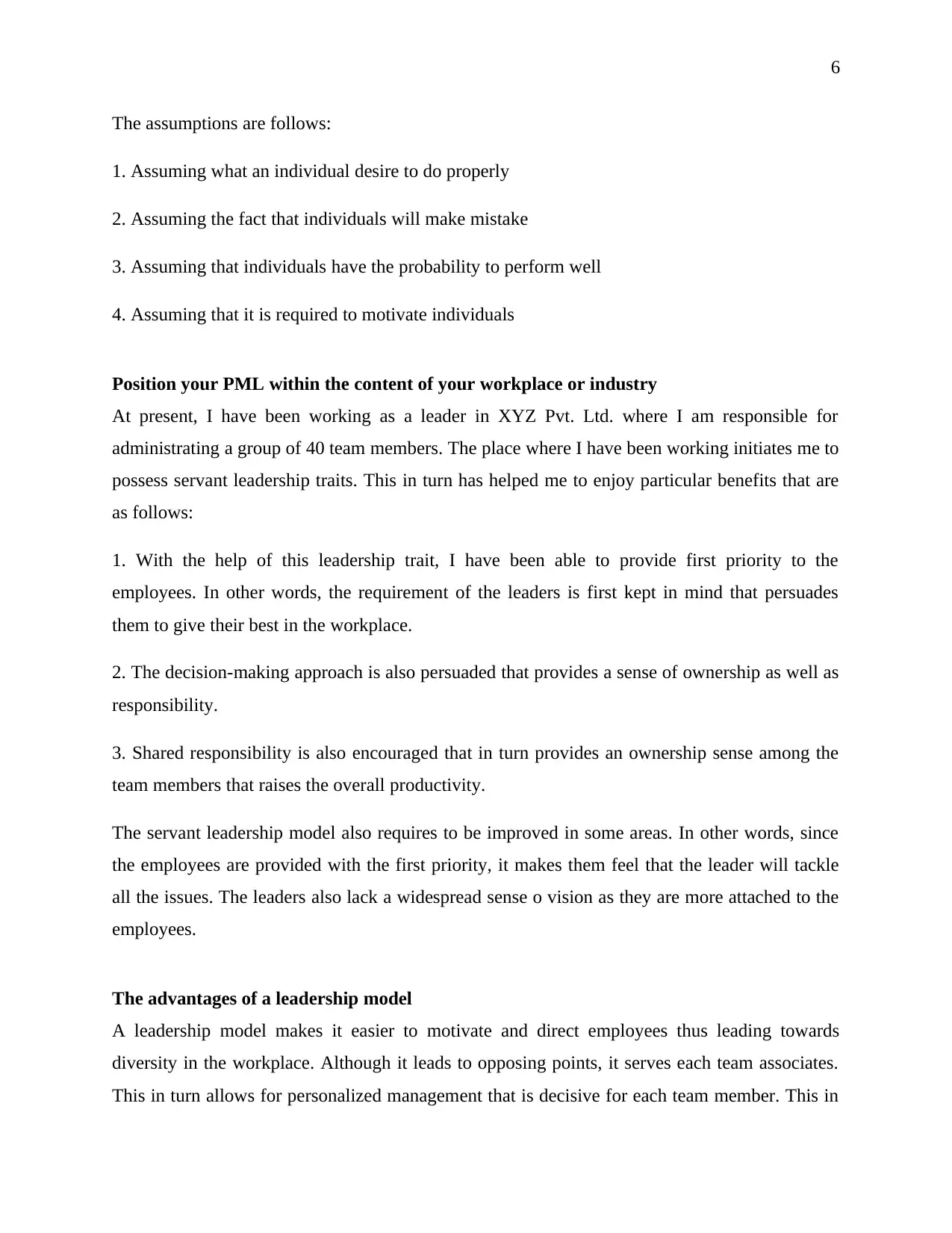
6
The assumptions are follows:
1. Assuming what an individual desire to do properly
2. Assuming the fact that individuals will make mistake
3. Assuming that individuals have the probability to perform well
4. Assuming that it is required to motivate individuals
Position your PML within the content of your workplace or industry
At present, I have been working as a leader in XYZ Pvt. Ltd. where I am responsible for
administrating a group of 40 team members. The place where I have been working initiates me to
possess servant leadership traits. This in turn has helped me to enjoy particular benefits that are
as follows:
1. With the help of this leadership trait, I have been able to provide first priority to the
employees. In other words, the requirement of the leaders is first kept in mind that persuades
them to give their best in the workplace.
2. The decision-making approach is also persuaded that provides a sense of ownership as well as
responsibility.
3. Shared responsibility is also encouraged that in turn provides an ownership sense among the
team members that raises the overall productivity.
The servant leadership model also requires to be improved in some areas. In other words, since
the employees are provided with the first priority, it makes them feel that the leader will tackle
all the issues. The leaders also lack a widespread sense o vision as they are more attached to the
employees.
The advantages of a leadership model
A leadership model makes it easier to motivate and direct employees thus leading towards
diversity in the workplace. Although it leads to opposing points, it serves each team associates.
This in turn allows for personalized management that is decisive for each team member. This in
The assumptions are follows:
1. Assuming what an individual desire to do properly
2. Assuming the fact that individuals will make mistake
3. Assuming that individuals have the probability to perform well
4. Assuming that it is required to motivate individuals
Position your PML within the content of your workplace or industry
At present, I have been working as a leader in XYZ Pvt. Ltd. where I am responsible for
administrating a group of 40 team members. The place where I have been working initiates me to
possess servant leadership traits. This in turn has helped me to enjoy particular benefits that are
as follows:
1. With the help of this leadership trait, I have been able to provide first priority to the
employees. In other words, the requirement of the leaders is first kept in mind that persuades
them to give their best in the workplace.
2. The decision-making approach is also persuaded that provides a sense of ownership as well as
responsibility.
3. Shared responsibility is also encouraged that in turn provides an ownership sense among the
team members that raises the overall productivity.
The servant leadership model also requires to be improved in some areas. In other words, since
the employees are provided with the first priority, it makes them feel that the leader will tackle
all the issues. The leaders also lack a widespread sense o vision as they are more attached to the
employees.
The advantages of a leadership model
A leadership model makes it easier to motivate and direct employees thus leading towards
diversity in the workplace. Although it leads to opposing points, it serves each team associates.
This in turn allows for personalized management that is decisive for each team member. This in
⊘ This is a preview!⊘
Do you want full access?
Subscribe today to unlock all pages.

Trusted by 1+ million students worldwide
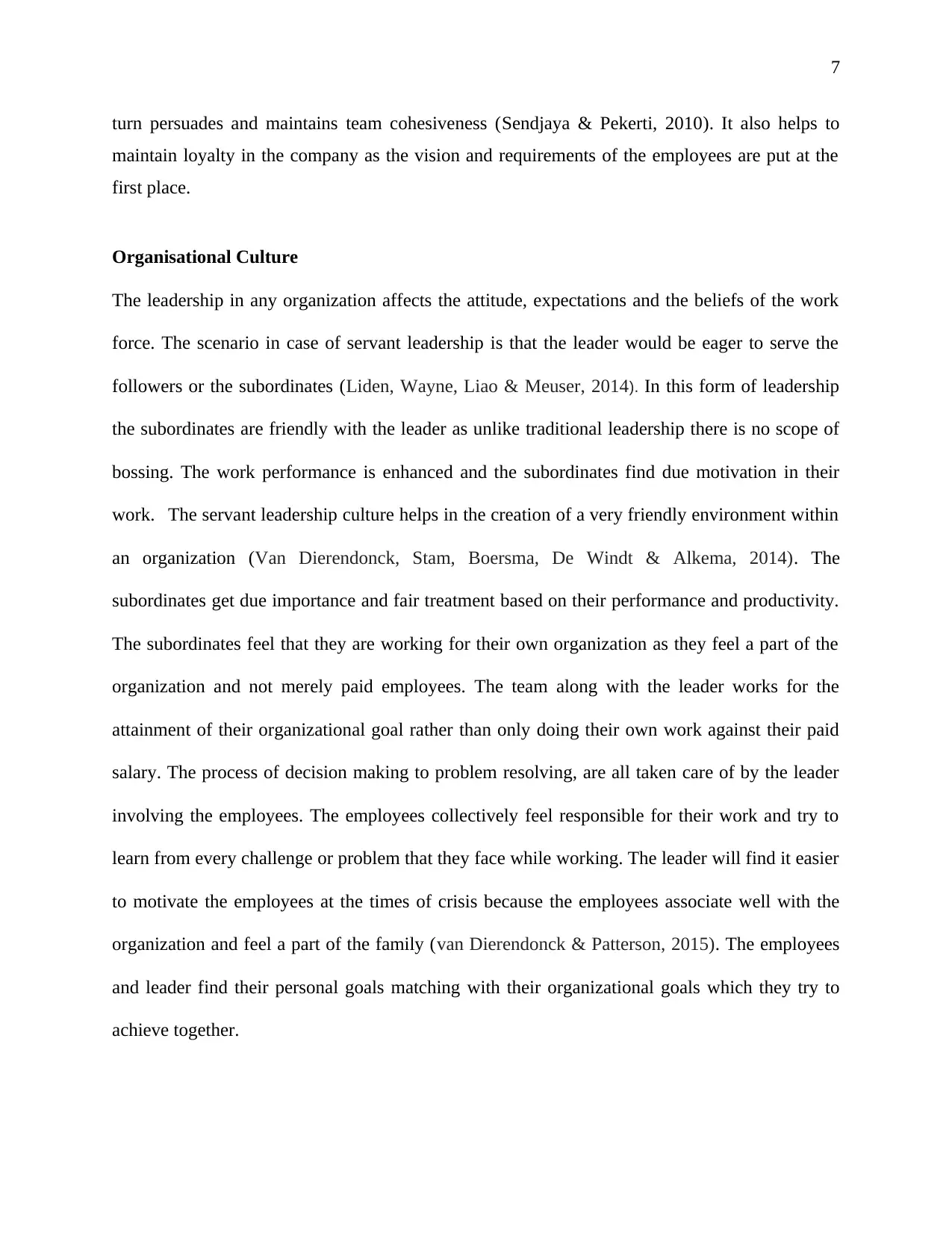
7
turn persuades and maintains team cohesiveness (Sendjaya & Pekerti, 2010). It also helps to
maintain loyalty in the company as the vision and requirements of the employees are put at the
first place.
Organisational Culture
The leadership in any organization affects the attitude, expectations and the beliefs of the work
force. The scenario in case of servant leadership is that the leader would be eager to serve the
followers or the subordinates (Liden, Wayne, Liao & Meuser, 2014). In this form of leadership
the subordinates are friendly with the leader as unlike traditional leadership there is no scope of
bossing. The work performance is enhanced and the subordinates find due motivation in their
work. The servant leadership culture helps in the creation of a very friendly environment within
an organization (Van Dierendonck, Stam, Boersma, De Windt & Alkema, 2014). The
subordinates get due importance and fair treatment based on their performance and productivity.
The subordinates feel that they are working for their own organization as they feel a part of the
organization and not merely paid employees. The team along with the leader works for the
attainment of their organizational goal rather than only doing their own work against their paid
salary. The process of decision making to problem resolving, are all taken care of by the leader
involving the employees. The employees collectively feel responsible for their work and try to
learn from every challenge or problem that they face while working. The leader will find it easier
to motivate the employees at the times of crisis because the employees associate well with the
organization and feel a part of the family (van Dierendonck & Patterson, 2015). The employees
and leader find their personal goals matching with their organizational goals which they try to
achieve together.
turn persuades and maintains team cohesiveness (Sendjaya & Pekerti, 2010). It also helps to
maintain loyalty in the company as the vision and requirements of the employees are put at the
first place.
Organisational Culture
The leadership in any organization affects the attitude, expectations and the beliefs of the work
force. The scenario in case of servant leadership is that the leader would be eager to serve the
followers or the subordinates (Liden, Wayne, Liao & Meuser, 2014). In this form of leadership
the subordinates are friendly with the leader as unlike traditional leadership there is no scope of
bossing. The work performance is enhanced and the subordinates find due motivation in their
work. The servant leadership culture helps in the creation of a very friendly environment within
an organization (Van Dierendonck, Stam, Boersma, De Windt & Alkema, 2014). The
subordinates get due importance and fair treatment based on their performance and productivity.
The subordinates feel that they are working for their own organization as they feel a part of the
organization and not merely paid employees. The team along with the leader works for the
attainment of their organizational goal rather than only doing their own work against their paid
salary. The process of decision making to problem resolving, are all taken care of by the leader
involving the employees. The employees collectively feel responsible for their work and try to
learn from every challenge or problem that they face while working. The leader will find it easier
to motivate the employees at the times of crisis because the employees associate well with the
organization and feel a part of the family (van Dierendonck & Patterson, 2015). The employees
and leader find their personal goals matching with their organizational goals which they try to
achieve together.
Paraphrase This Document
Need a fresh take? Get an instant paraphrase of this document with our AI Paraphraser
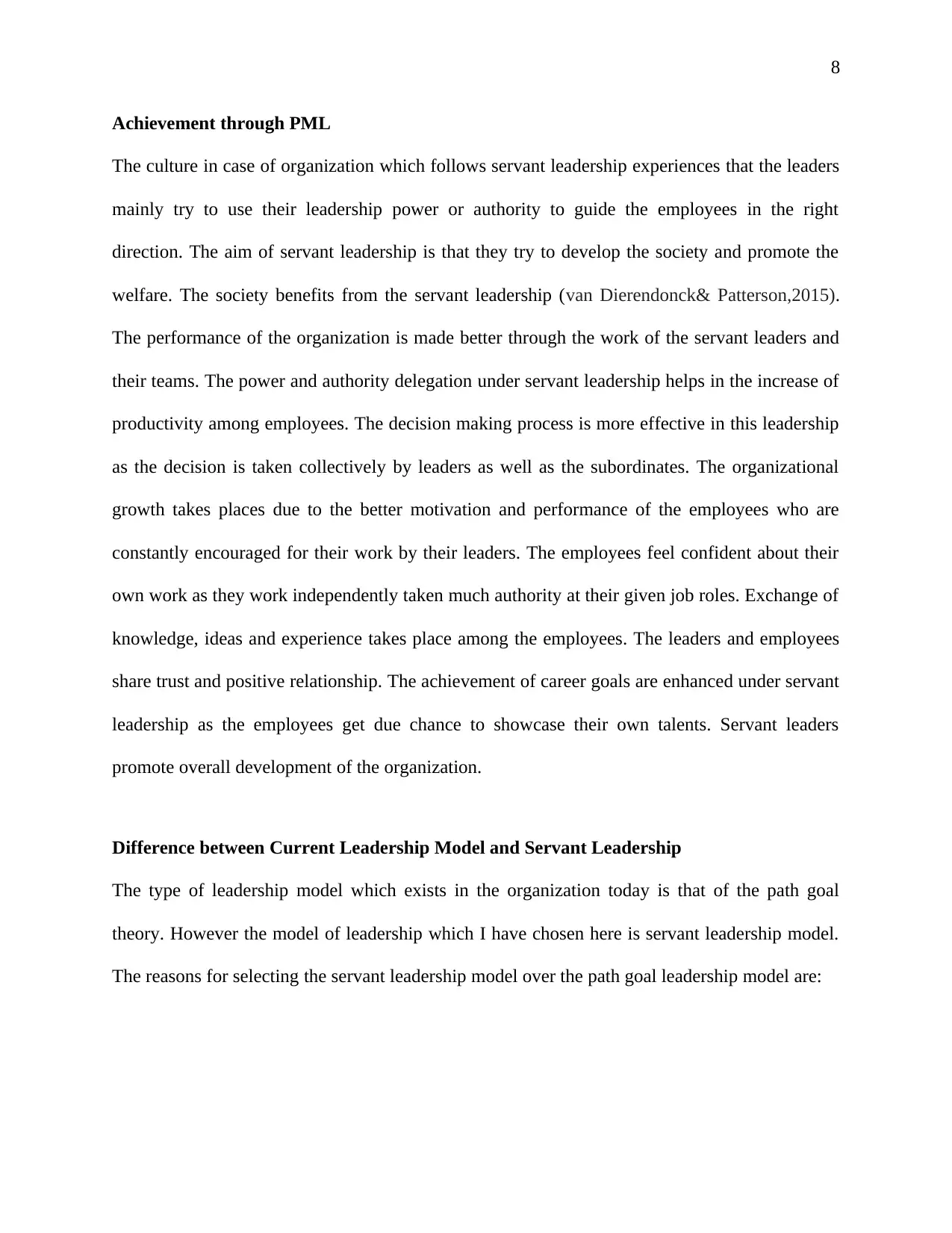
8
Achievement through PML
The culture in case of organization which follows servant leadership experiences that the leaders
mainly try to use their leadership power or authority to guide the employees in the right
direction. The aim of servant leadership is that they try to develop the society and promote the
welfare. The society benefits from the servant leadership (van Dierendonck& Patterson,2015).
The performance of the organization is made better through the work of the servant leaders and
their teams. The power and authority delegation under servant leadership helps in the increase of
productivity among employees. The decision making process is more effective in this leadership
as the decision is taken collectively by leaders as well as the subordinates. The organizational
growth takes places due to the better motivation and performance of the employees who are
constantly encouraged for their work by their leaders. The employees feel confident about their
own work as they work independently taken much authority at their given job roles. Exchange of
knowledge, ideas and experience takes place among the employees. The leaders and employees
share trust and positive relationship. The achievement of career goals are enhanced under servant
leadership as the employees get due chance to showcase their own talents. Servant leaders
promote overall development of the organization.
Difference between Current Leadership Model and Servant Leadership
The type of leadership model which exists in the organization today is that of the path goal
theory. However the model of leadership which I have chosen here is servant leadership model.
The reasons for selecting the servant leadership model over the path goal leadership model are:
Achievement through PML
The culture in case of organization which follows servant leadership experiences that the leaders
mainly try to use their leadership power or authority to guide the employees in the right
direction. The aim of servant leadership is that they try to develop the society and promote the
welfare. The society benefits from the servant leadership (van Dierendonck& Patterson,2015).
The performance of the organization is made better through the work of the servant leaders and
their teams. The power and authority delegation under servant leadership helps in the increase of
productivity among employees. The decision making process is more effective in this leadership
as the decision is taken collectively by leaders as well as the subordinates. The organizational
growth takes places due to the better motivation and performance of the employees who are
constantly encouraged for their work by their leaders. The employees feel confident about their
own work as they work independently taken much authority at their given job roles. Exchange of
knowledge, ideas and experience takes place among the employees. The leaders and employees
share trust and positive relationship. The achievement of career goals are enhanced under servant
leadership as the employees get due chance to showcase their own talents. Servant leaders
promote overall development of the organization.
Difference between Current Leadership Model and Servant Leadership
The type of leadership model which exists in the organization today is that of the path goal
theory. However the model of leadership which I have chosen here is servant leadership model.
The reasons for selecting the servant leadership model over the path goal leadership model are:
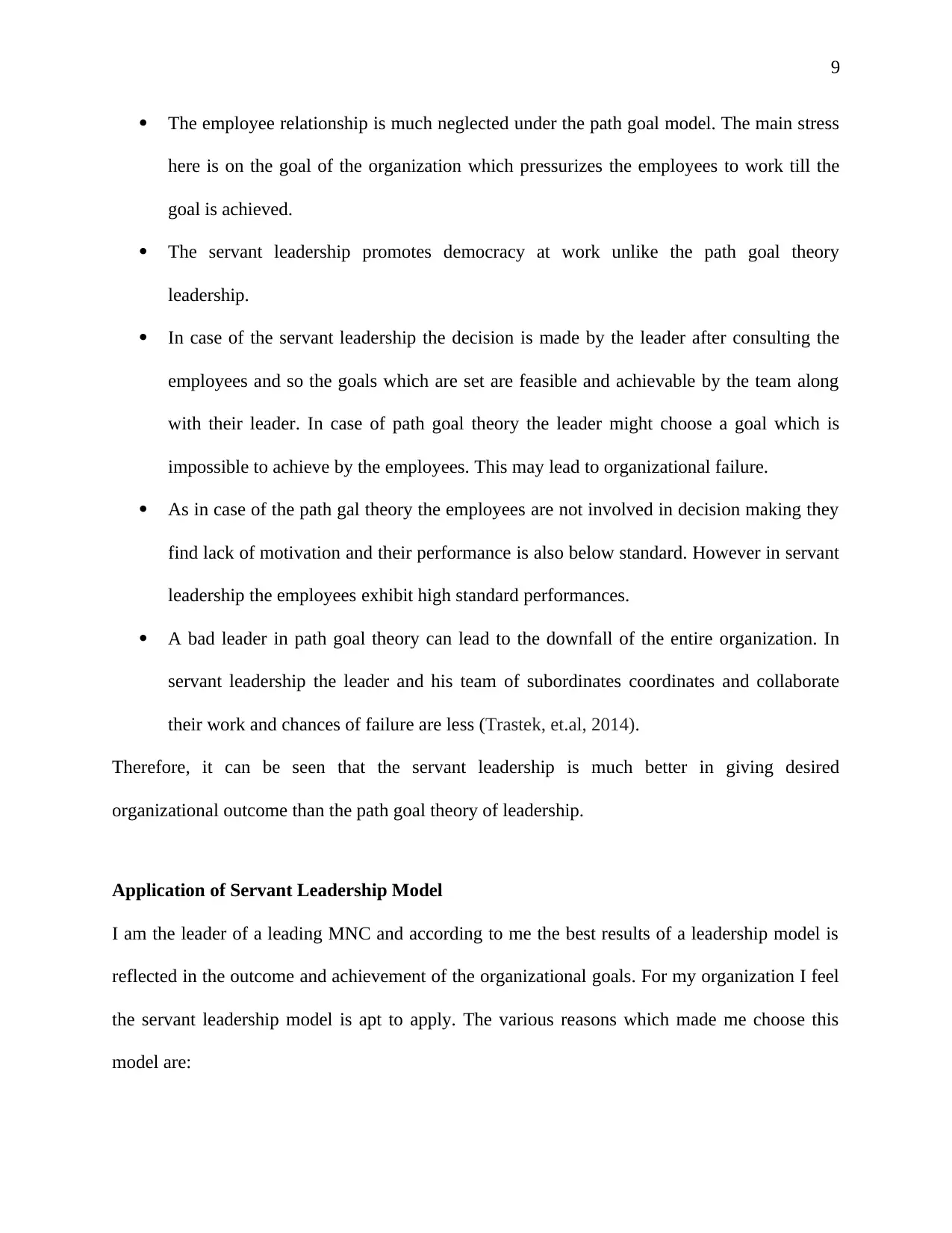
9
The employee relationship is much neglected under the path goal model. The main stress
here is on the goal of the organization which pressurizes the employees to work till the
goal is achieved.
The servant leadership promotes democracy at work unlike the path goal theory
leadership.
In case of the servant leadership the decision is made by the leader after consulting the
employees and so the goals which are set are feasible and achievable by the team along
with their leader. In case of path goal theory the leader might choose a goal which is
impossible to achieve by the employees. This may lead to organizational failure.
As in case of the path gal theory the employees are not involved in decision making they
find lack of motivation and their performance is also below standard. However in servant
leadership the employees exhibit high standard performances.
A bad leader in path goal theory can lead to the downfall of the entire organization. In
servant leadership the leader and his team of subordinates coordinates and collaborate
their work and chances of failure are less (Trastek, et.al, 2014).
Therefore, it can be seen that the servant leadership is much better in giving desired
organizational outcome than the path goal theory of leadership.
Application of Servant Leadership Model
I am the leader of a leading MNC and according to me the best results of a leadership model is
reflected in the outcome and achievement of the organizational goals. For my organization I feel
the servant leadership model is apt to apply. The various reasons which made me choose this
model are:
The employee relationship is much neglected under the path goal model. The main stress
here is on the goal of the organization which pressurizes the employees to work till the
goal is achieved.
The servant leadership promotes democracy at work unlike the path goal theory
leadership.
In case of the servant leadership the decision is made by the leader after consulting the
employees and so the goals which are set are feasible and achievable by the team along
with their leader. In case of path goal theory the leader might choose a goal which is
impossible to achieve by the employees. This may lead to organizational failure.
As in case of the path gal theory the employees are not involved in decision making they
find lack of motivation and their performance is also below standard. However in servant
leadership the employees exhibit high standard performances.
A bad leader in path goal theory can lead to the downfall of the entire organization. In
servant leadership the leader and his team of subordinates coordinates and collaborate
their work and chances of failure are less (Trastek, et.al, 2014).
Therefore, it can be seen that the servant leadership is much better in giving desired
organizational outcome than the path goal theory of leadership.
Application of Servant Leadership Model
I am the leader of a leading MNC and according to me the best results of a leadership model is
reflected in the outcome and achievement of the organizational goals. For my organization I feel
the servant leadership model is apt to apply. The various reasons which made me choose this
model are:
⊘ This is a preview!⊘
Do you want full access?
Subscribe today to unlock all pages.

Trusted by 1+ million students worldwide
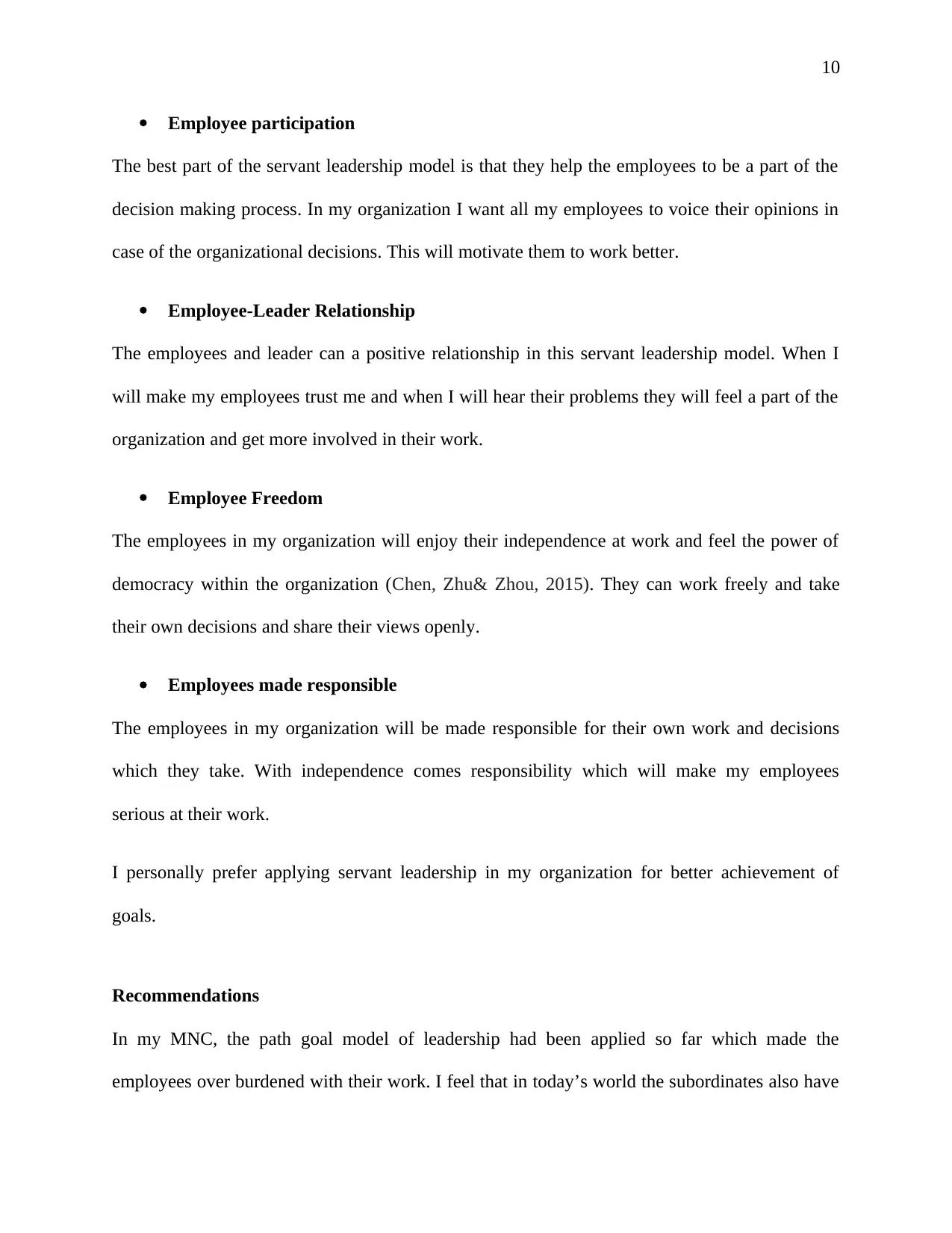
10
Employee participation
The best part of the servant leadership model is that they help the employees to be a part of the
decision making process. In my organization I want all my employees to voice their opinions in
case of the organizational decisions. This will motivate them to work better.
Employee-Leader Relationship
The employees and leader can a positive relationship in this servant leadership model. When I
will make my employees trust me and when I will hear their problems they will feel a part of the
organization and get more involved in their work.
Employee Freedom
The employees in my organization will enjoy their independence at work and feel the power of
democracy within the organization (Chen, Zhu& Zhou, 2015). They can work freely and take
their own decisions and share their views openly.
Employees made responsible
The employees in my organization will be made responsible for their own work and decisions
which they take. With independence comes responsibility which will make my employees
serious at their work.
I personally prefer applying servant leadership in my organization for better achievement of
goals.
Recommendations
In my MNC, the path goal model of leadership had been applied so far which made the
employees over burdened with their work. I feel that in today’s world the subordinates also have
Employee participation
The best part of the servant leadership model is that they help the employees to be a part of the
decision making process. In my organization I want all my employees to voice their opinions in
case of the organizational decisions. This will motivate them to work better.
Employee-Leader Relationship
The employees and leader can a positive relationship in this servant leadership model. When I
will make my employees trust me and when I will hear their problems they will feel a part of the
organization and get more involved in their work.
Employee Freedom
The employees in my organization will enjoy their independence at work and feel the power of
democracy within the organization (Chen, Zhu& Zhou, 2015). They can work freely and take
their own decisions and share their views openly.
Employees made responsible
The employees in my organization will be made responsible for their own work and decisions
which they take. With independence comes responsibility which will make my employees
serious at their work.
I personally prefer applying servant leadership in my organization for better achievement of
goals.
Recommendations
In my MNC, the path goal model of leadership had been applied so far which made the
employees over burdened with their work. I feel that in today’s world the subordinates also have
Paraphrase This Document
Need a fresh take? Get an instant paraphrase of this document with our AI Paraphraser
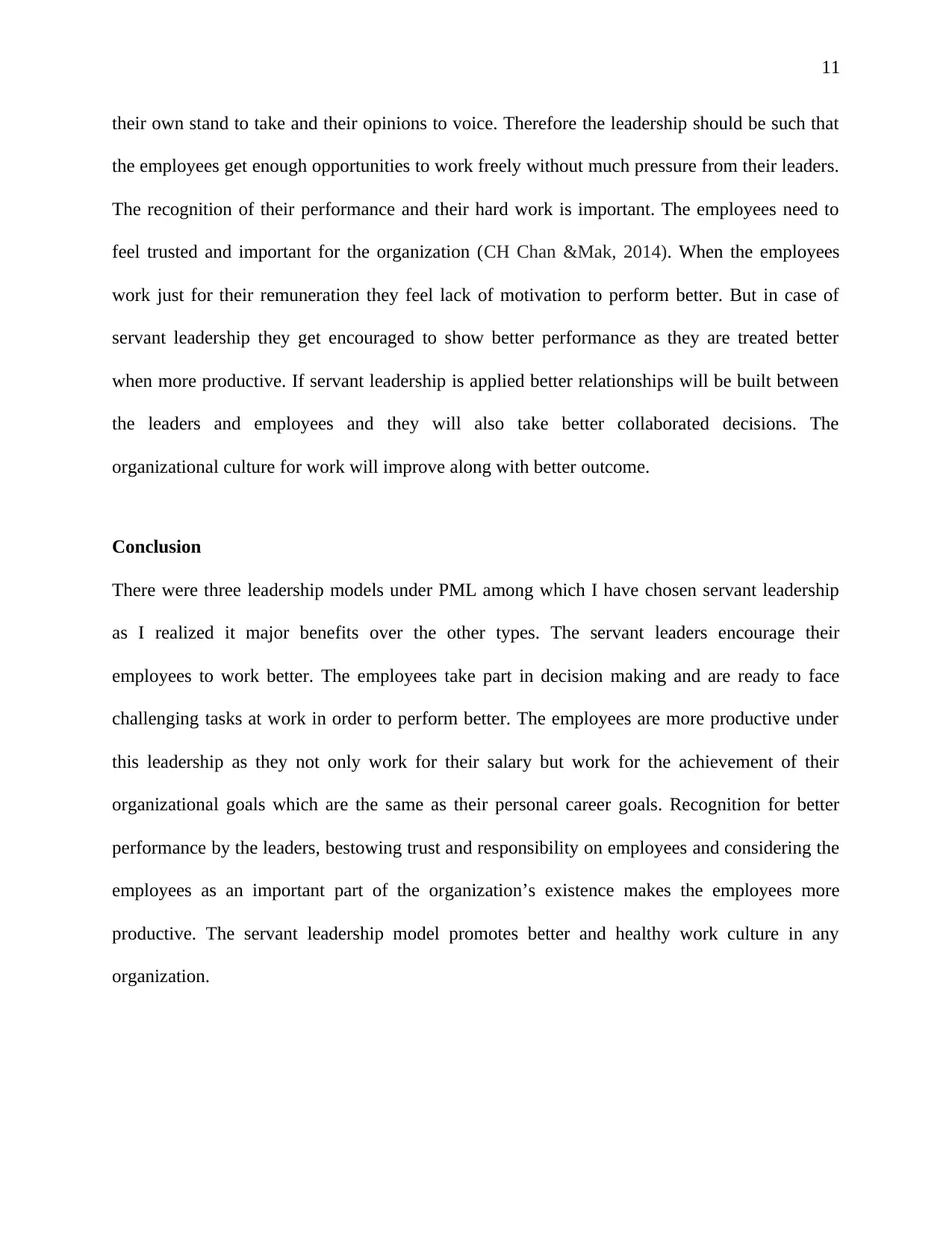
11
their own stand to take and their opinions to voice. Therefore the leadership should be such that
the employees get enough opportunities to work freely without much pressure from their leaders.
The recognition of their performance and their hard work is important. The employees need to
feel trusted and important for the organization (CH Chan &Mak, 2014). When the employees
work just for their remuneration they feel lack of motivation to perform better. But in case of
servant leadership they get encouraged to show better performance as they are treated better
when more productive. If servant leadership is applied better relationships will be built between
the leaders and employees and they will also take better collaborated decisions. The
organizational culture for work will improve along with better outcome.
Conclusion
There were three leadership models under PML among which I have chosen servant leadership
as I realized it major benefits over the other types. The servant leaders encourage their
employees to work better. The employees take part in decision making and are ready to face
challenging tasks at work in order to perform better. The employees are more productive under
this leadership as they not only work for their salary but work for the achievement of their
organizational goals which are the same as their personal career goals. Recognition for better
performance by the leaders, bestowing trust and responsibility on employees and considering the
employees as an important part of the organization’s existence makes the employees more
productive. The servant leadership model promotes better and healthy work culture in any
organization.
their own stand to take and their opinions to voice. Therefore the leadership should be such that
the employees get enough opportunities to work freely without much pressure from their leaders.
The recognition of their performance and their hard work is important. The employees need to
feel trusted and important for the organization (CH Chan &Mak, 2014). When the employees
work just for their remuneration they feel lack of motivation to perform better. But in case of
servant leadership they get encouraged to show better performance as they are treated better
when more productive. If servant leadership is applied better relationships will be built between
the leaders and employees and they will also take better collaborated decisions. The
organizational culture for work will improve along with better outcome.
Conclusion
There were three leadership models under PML among which I have chosen servant leadership
as I realized it major benefits over the other types. The servant leaders encourage their
employees to work better. The employees take part in decision making and are ready to face
challenging tasks at work in order to perform better. The employees are more productive under
this leadership as they not only work for their salary but work for the achievement of their
organizational goals which are the same as their personal career goals. Recognition for better
performance by the leaders, bestowing trust and responsibility on employees and considering the
employees as an important part of the organization’s existence makes the employees more
productive. The servant leadership model promotes better and healthy work culture in any
organization.

12
⊘ This is a preview!⊘
Do you want full access?
Subscribe today to unlock all pages.

Trusted by 1+ million students worldwide
1 out of 14
Related Documents
Your All-in-One AI-Powered Toolkit for Academic Success.
+13062052269
info@desklib.com
Available 24*7 on WhatsApp / Email
![[object Object]](/_next/static/media/star-bottom.7253800d.svg)
Unlock your academic potential
Copyright © 2020–2025 A2Z Services. All Rights Reserved. Developed and managed by ZUCOL.





